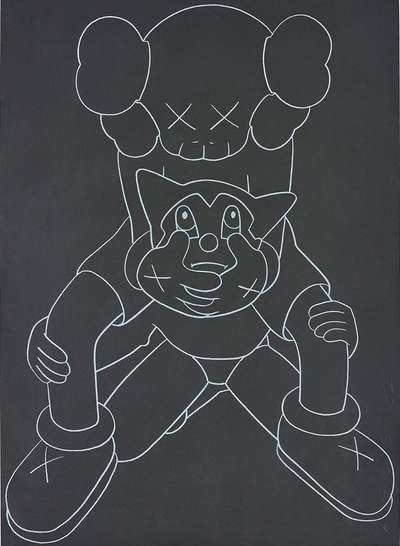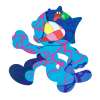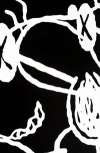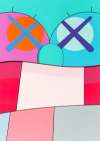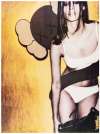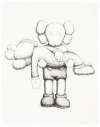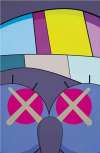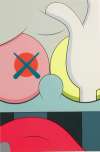Astro
Boy
Astro Boy showcases KAW’s voracious ingestion of television around the early 2000s, and his turn to populating his artistic universe with appropriated cartoon characters— Mickey Mouse, the Smurfs, characters from Sesame Street and The Simpsons —alongside his own. Despite this turn, KAWS renders all characters originally, with signature cross-eyes.
KAWS Astro Boy For sale
Astro Boy Value (5 Years)
Sales data across the Astro Boy series by KAWS varies by print. While standout works have sold at auction for up to £11000, other editions in the series remain rare to market or have yet to appear publicly for sale. Of those tracked, average selling prices have ranged from £2021 to £2021, with an annual growth rate of 0.89% across available data. Collectors should note the discrepancy in performance between more visible and lesser-seen editions when considering value potential in this series.
Astro Boy Market value
Auction Results
| Artwork | Auction Date | Auction House | Return to Seller | Hammer Price | Buyer Paid |
|---|---|---|---|---|---|
 Companion Vs Astroboy KAWS Signed Print | 2 Oct 2025 | Mallet Japan | £1,700 | £2,000 | £2,350 |
Sell Your Art
with Us
with Us
Join Our Network of Collectors. Buy, Sell and Track Demand
Meaning & Analysis
As we see in Companion vs. Astro-Boy, (2008) KAWS blends his own characters with those recognisable from Pop-Culture in his prints. KAWS, (born Brian Donnelly), has taken the art world by storm and his career as an artist who bridges the gap between art and design has developed rapidly since the late 1990s.
Like other renowned artists such as Keith Haring and Jean- Michel Basquiat, KAWS started experimenting with art and design through graffiti. As a teenager, Donnelly created the tag ‘KAWS’, which the artist goes by today, due to the way the letters looked when arranged together in bubble writing. Donnelly started tagging buildings in New Jersey, where the artist grew up, and went on to develop his artistic talents at the School of Visual Arts in New York where he studied illustration and graduated with a Bachelor of Fine Arts in 1996. KAWS then went on to work as a freelance animator for Jumbo Pictures, where he honed his excellent draughtsmanship, working on the backgrounds of animation series such as 101 Dalmatians, Daria and Doug.
KAWS’ study of illustration and early career in animation clearly marks his artworks today. As seen in the Astro Boy collection, KAWS has developed an artistic style characterised by an emphasis on colour, bold gestural lines and a set of distinctive graphics that have become closely associated with the artist’s name. An example of this is the print Astro Boy Vs Pikachu, in which KAWS reworks the familiar cartoon character, Astro Boy, adding his iconic crossed out eyes, a trademark feature of the artist’s visual language.
In Astro Boy, KAWS takes a set of well-known cartoon characters, such as Astro Boy and Pikachu, and renders them in his signature artistic style. The artist also frequently creates his own figurative characters, and has produced an iconic stock of cartoon icons, such as Companion, Chum, Accomplice and Bendy. The creation of these icons resonates strongly with the work of Keith Haring and his impressive collection of repeated icons and motifs, such as the radiant baby, angel, flying devil and barking dog. KAWS’ characters are simple and charming and often appear in timid and shy poses. The characters have brought KAWS international recognition and fame, imbuing the artist with Pop status as a cultural icon of the 21st century who has successfully bridged the division between street art and high art.
Astro Boy also reflects KAWS’ turn to television in the early 2000s, in which the artist chose to work with a variety of well-known cartoon characters, as opposed to his original creations. Along with Astro Boy and Pikachu, the artist appropriated and adapted familiar figures such as Mickey Mouse, the Smurfs, characters from Sesame Street and The Simpsons. All these figures were rendered in his signature visual style, with skull and cross-bone heads and crossed out eyes.
KAWS’ visual style carries an air of morbidity which contrasts with the light-hearted characters he chooses to depict. This can be read as a sardonic comment on globalised culture and the state of contemporary society.
As well as Haring and Basquiat, other artists that have influenced KAWS and his artistic development are traditional painters such as Gerhard Richter, Claes Oldenburg and Chuck Close. KAWS has also been likened to Andy Warhol due to his ability to blur the boundaries between high and low art and his interest in popular culture and incorporation of well-known Pop culture references into his artworks.
